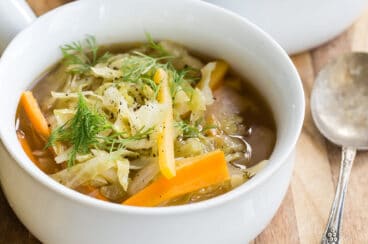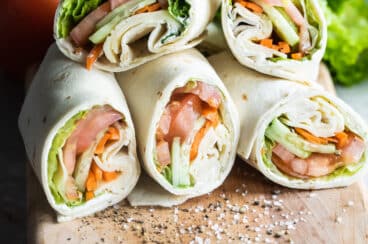This post may contain affiliate links. For more information, please see our affiliate policy.
When salads, stir-fries, and other vegetable recipes call for julienned carrots, here’s what to do. Learning How to Julienne Carrots is definitely easier than it looks, and everyone will be seriously impressed with your professional knife skills.

You’ve stumbled on this little how-to probably because you needed to know more about cutting up carrots. Particularly, how to julienne them.
It’s not hard—not by a long shot— and you can use this method on zucchini, summer squash, and cucumbers, too. All you need is a cutting board and a sharp chef’s knife.
Why (and when) do you julienne vegetables?
- Easier to bite small pieces
- Ensure different ingredients in a recipe cook quickly and evenly
- Better texture for sandwiches and wraps
- Pretty garnish for salads or soups
How to Julienne Carrots:
- Before you start, prepare the carrots. Wash them, pat them dry, and peel them. (You don’t always have to peel carrots, but unpeeled carrots are rustic, and julienned carrots are NOT rustic. I recommend peeling them for this.)
- Next, trim off the stem end and root tip of the carrot. Then cut the carrots into even lengths, usually about 2 inches long. Anything longer and the pieces might get tricky to eat.
- Working with one piece of carrot at a time, slice off one side of each “log” to make a flat surface. This will prevent the carrot from rolling on your work surface as you cut.
- Place the carrot down on that flat side you just made and slice the carrot into thin, 1/8-inch “planks.”
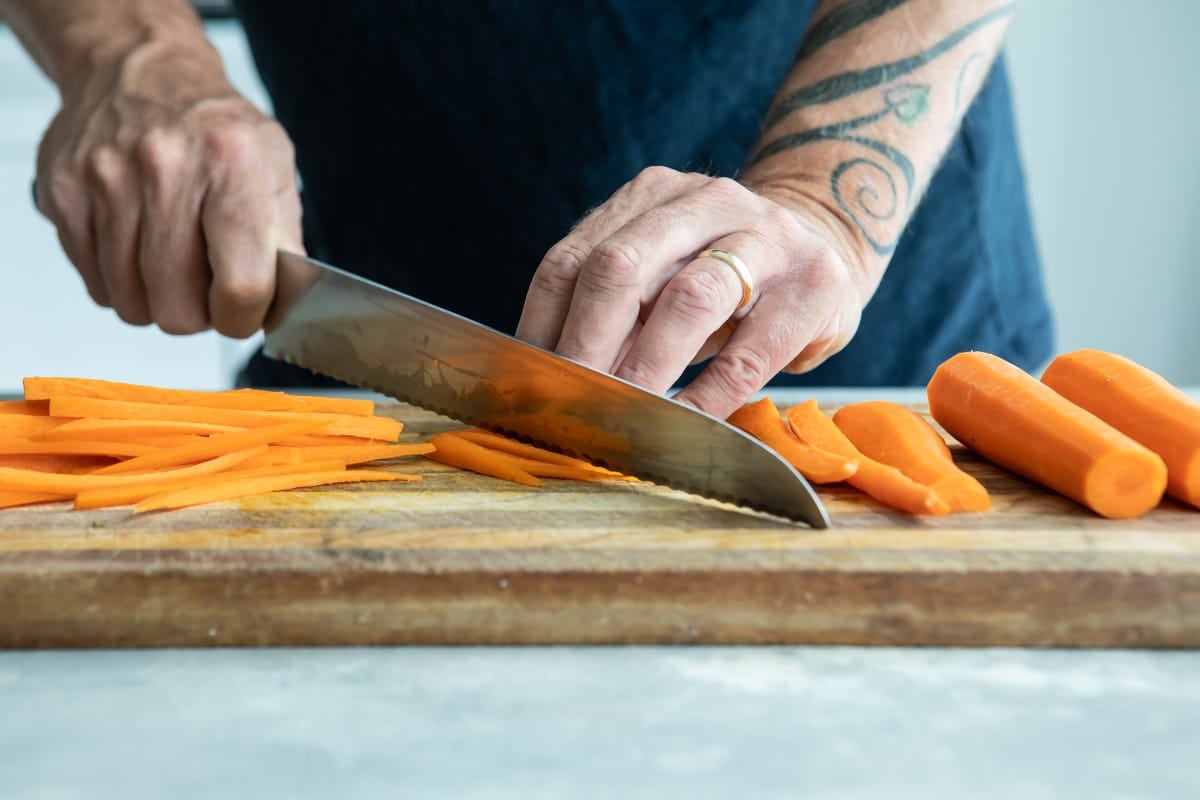
- Once you have several planks, stack them on top of one another and slice through the stack to create thin, 1/8-inch strips—similar to matchsticks.
Want to learn other terms for cutting vegetables?
- Baton. This is the shape you usually get with steak fries—a chunky, thick stick cut. Cut batons cross-wise, and you get what’s called a “medium dice.”
- Batonnet. aka French fries and vegetable sticks for crudité platters! Thinner than a baton, Cut batonnets cross-wise and you get what the culinary world refers to as a “small dice.”
- Julienne. Also known as a matchstick cut, thinner than a batonnet. Cut these cross-wise into the famous brunoise (fine dice).
- Brunoise. Explained above. Any finer, and this cut would be called a “mince.”
- Paysanne. A rustic cut that lets the natural shape of the vegetable remain. Think “coins” or rounds of carrot, zucchini, or cucumber. This cut can be any thickness, from thin to chunky.
- Chiffonade. A cut that is used for leafy greens, herbs, and even citrus peel to create thin ribbons of flavorful ingredients, often for garnishes. To do this, stack the leaves together and roll them tightly, holding them down with your fingertips while slicing the leaves perpendicular to the roll to create thin pieces.
Great recipes for practicing your technique
Salad Recipes
Easy Garden Salad
Soup and Stew Recipes
Cabbage Soup
Sandwich Recipes
Veggie Wrap Recipe
Salad Recipes
Chinese Chicken Salad
Join Us
How to Julienne Carrots
Ingredients
- 4 carrots peeled
Instructions
- Trim off stem end and root tip of carrot. Cut carrots into even lengths, about 2 inches long each.
- Working with one piece of carrot at a time, slice off one side of each “log” to make a flat surface. This will prevent the carrot from rolling on your work surface as you cut.
- Place the carrot down on that flat side you just made and slice the carrot into thin, 1/8-inch “planks.”
- Once you have several planks, stack them on top of one another and slice through the stack to create thin, 1/8-inch strips—similar to matchsticks.
Nutrition
Meggan Hill is a classically-trained chef and professional writer. Her meticulously-tested recipes and detailed tutorials bring confidence and success to home cooks everywhere. Meggan has been featured on NPR, HuffPost, FoxNews, LA Times, and more.
